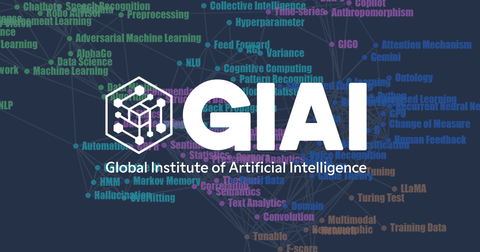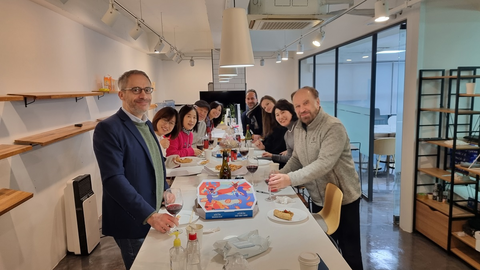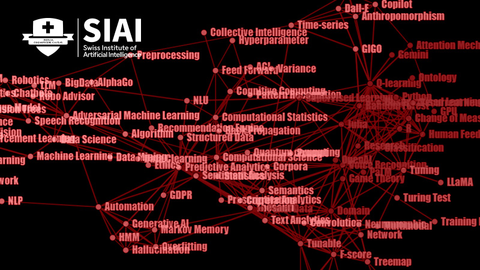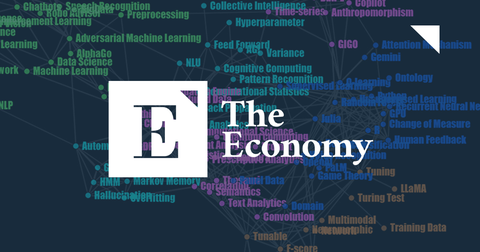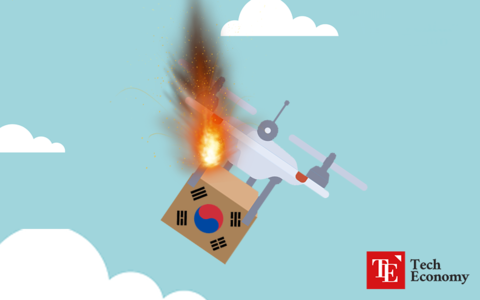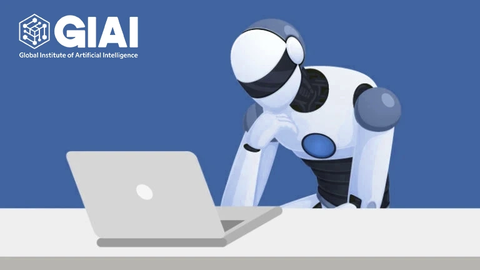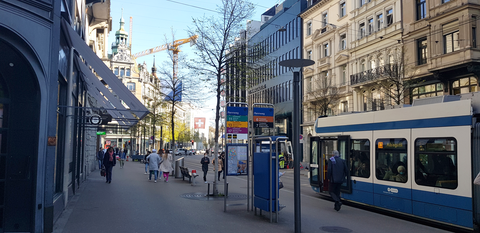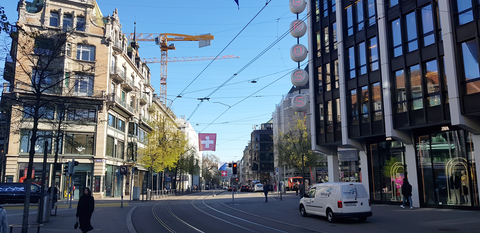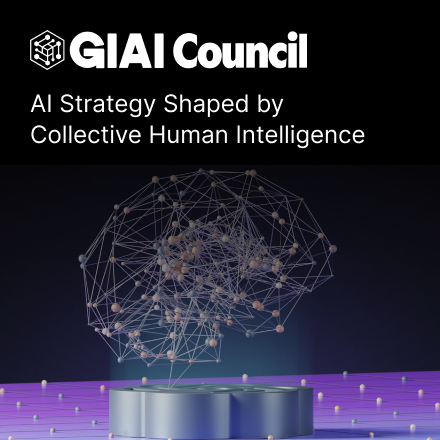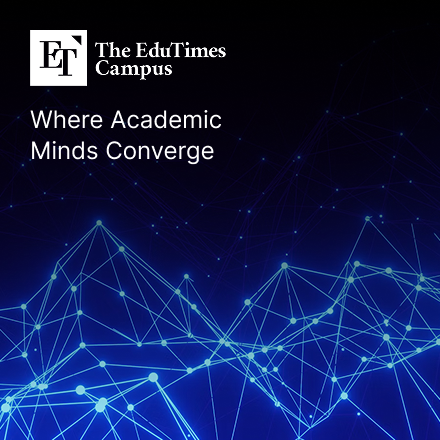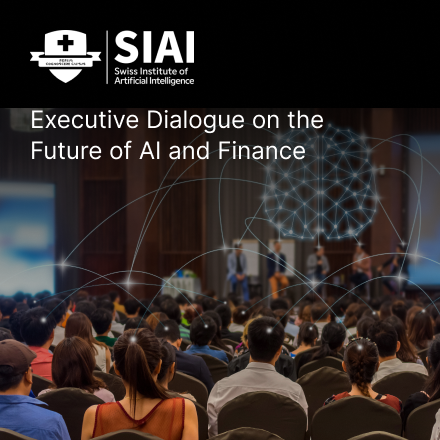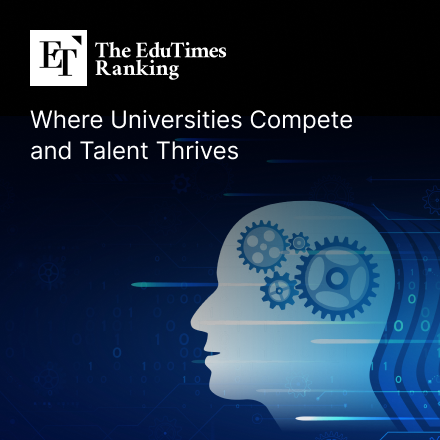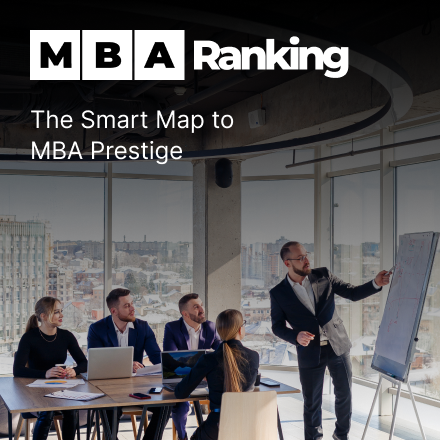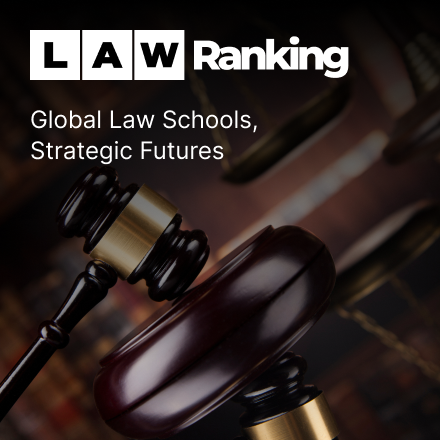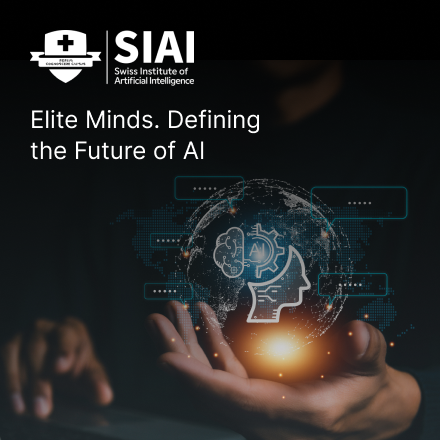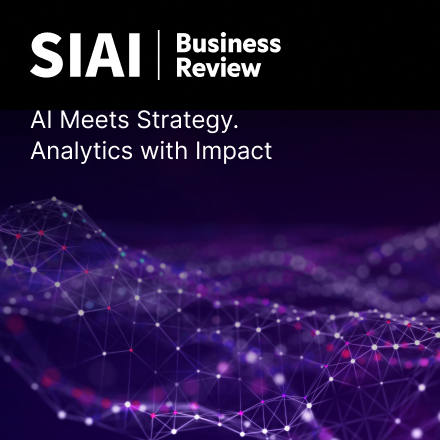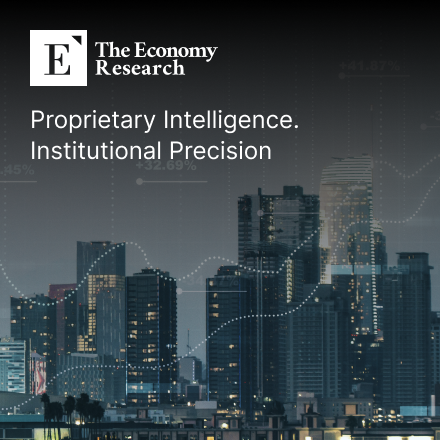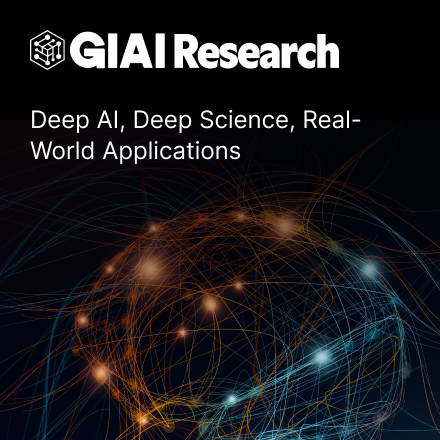Economy Analysis Listing
All Economy Analysis
GIAOKr News
All GIAIkr News
Giaikr
[공지] 한국어 웹사이트 The Economy Korea로 통합 및 GIAI Square 분리 개편
Published

안녕하세요,
1.GIAI Korea 산하 한국어 웹사이트 통합
오는 5월 1일을 기준으로 GIAI Korea가 운영 중인 아래의 웹사이트들이 The Economy Korea 아래로 통합됩니다.
- GIAI Korea: https://kr.giai.org -> https://kr.economy.ac/giaikr
- GIAI Korea Books: https://kr.giai.org/books -> https://kr.economy.ac/books
- 파이낸셜 이코노미: https://financial.economy.ac -> https://kr.economy.ac/financial
- 폴리시 이코노미: https://policy.economy.ac -> https://kr.economy.ac/policy
- 바이오 이코노미: https://bio.economy.ac -> https://kr.economy.ac/bio
- 테크 이코노미: https://tech.economy.ac -> https://kr.economy.ac/tech
- OTT랭킹: https://kr.ottranking.com -> https://kr.economy.ac/ottkr
본 작업을 통해 The Economy Korea가 금융시장, 정책, 바이오/테크 산업 전반에 걸친 전문 경제지로 통합되는 것과 더불어, GIAI Korea로 전달되던 GIAI Research의 AI/Data Science 연구, OTT랭킹을 통해 한국어로 제공되던 K-콘텐츠 관련 영문 매거진(OTT Ranking)을 묶은 종합경제지로 발돋움할 수 있을 것으로 믿습니다.
본 통합 작업을 통해 The Economy Korea가 GIAI에서 운영 중인 각종 서비스들의 한국어 사용자들을 위한 일원화된 창구로 자리매김할 수 있게 되기를 바랍니다.
2.GIAI Square 한국어 서비스 폐지
현재 GIAI Square에 더부살이를 하고 있는 한국어 게시판(GIAI Korea, SIAI Korea, The Economy Korea 등)은 이번 개편과 함께 완전히 폐지됩니다.
GIAI Square 서비스 개설 당시만해도 SIAI의 한국인 학생들을 대상으로 한 커뮤니티가 계획의 일부로 포함되어 있었습니다만, 학생들의 참여를 억지로 끌어내기보다는 당사의 콘텐츠 시스템에 맞춰 운영 구조를 변경하게 됐습니다.
따라서 SIAI Korea라는 이름으로 운영되면서 SIAI의 한국 서비스 운영과 관련된 국내 시장에 대한 각종 평가 관련해 작성된 게시글의 경우, GIAI Korea 내의 블로그 기고 글, 또는 Books 콘텐츠로 변환 과정을 거칠 예정입니다..
3.GIAI Square 분리 개편
위의 독립된 웹사이트 출시와 더불어, 본사(GIAI)에서 영어권 이용자들을 대상으로 운영 중인 연구 및 교육 조직, 언론 조직 (The EduTimes, The Economy, OTT Ranking)에 맞춰 GIAI Square가 아래 4개 서비스로 분리 됩니다.
- GIAI Council: https://council.giai.org - GIAI 연구진 및 관계자, SIAI 학생 대상 (각각에 등급 배정 예정)
- The EduTimes Campus: https://campus.edutimes.com - 대학생 및 교직원 대상 커뮤니티
- 1Korea: https://1korea.com - 해외에서 한국의 방송·연예, 거주, 학업, 구직 등의 정보를 찾는 분들을 대상으로 한 커뮤니티
- The Economy Secret: https://secret.economy.ac - 기업 분석 자료 공유 커뮤니티
각각의 서비스에 당사에서 제공하는 영문 전문지가 연동될 예정입니다.
안타깝게도 한국어 서비스가 제공되지는 않습니다만, 그간 GIAI Korea, The Economy Korea를 통해 당사 한국어 서비스에 접근했던 관계자 분들을 위해 관련해서 아래 2개 서비스를 간단하게 소개해드립니다.
GIAI Council은 조직의 확장에 따라 교수진 및 연구진들이 GIAI 외부의 연구진 및 관계자들과 소통하기 위해 만들어진 커뮤니티입니다. SIAI 학생의 경우, 지원 시점 및 재학 중에는 예비 회원, 학위 과정을 졸업하면 GIAI 정규 회원으로, 박사 과정 등을 거치며 학문적인 성과를 쌓은 경우는 상위 등급의 회원으로 변경하는 방식의 등급 시스템이 도입됩니다.
The Economy Secret의 경우, 다루게 되는 콘텐츠는 AI/Data Science를 비롯한 기술 산업 전반에서 기업들이 밝히지 않는 진실, 취재원 보호 차원에서 기사 형태로 언급되기 매우 어려운 내용들을 계획 중입니다. 그 중 한국 기업들에 대한 예시는 아래와 같습니다.
- 모 방산 대기업이 미사일에 쓰이는 항법 장치의 Calibration을 못해서 항법 장치 공급사인 스위스의 모 기업의 학부 출신 막내 직원이 한국에 출장와서 문제를 해결해 줄 때까지 2달이나 허비했던 사례 (참고로 Calibration은 대부분의 STEM 전공에서 학부 고학년, 늦어도 박사 1~2학년 과정 중에 배우는, 학자들 대상으로는 기초 지식에 해당됩니다.)
- 모 IT 자회사를 상장시키던 대기업이 탄탄한 기술력을 바탕으로 해외 프로젝트 수주를 통해 높은 밸류에이션을 납득 시키겠다고 주장했지만, 실제로는 대기업 계열사 전체가 해당 IT 자회사의 사내 시스템에 대한 불편을 강력하게 주장한 탓에 결국 그룹 전체가 Microsoft Teams를 쓰게 될 만큼 기술력에 문제가 있는 사례
등입니다. 실제 커뮤니티 내에서는 해당 기업의 실명은 물론이고, 몇몇 대기업의 해당 업무 담당자 이름까지 등장할 수도 있는 만큼, 소수의 관계자들을 대상으로만 운영될 예정입니다. 공매도(Short Selling) 등의 투자 기법을 이용하는 행동주의 헤지펀드 등에게 유용한 정보가 될 것으로 예상하고 있습니다. 이에 따라 커뮤니티의 이름도 'Secret'으로 확정이 됐습니다.
더불어 SIAI에 Case Study 등의 교육 자료로 쓰이고 있는 콘텐츠를 변환해, 고급 전문 투자자를 위해 주요 기술 기업들의 실제 기술력 수준에 대한 전문 분석 보고서로 제공할 계획도 있습니다. 콘텐츠 변환을 위한 정지 작업이 완료되면 재공지하도록 하겠습니다.
모든 서비스가 영어권 사용자를 대상으로 운영될 예정인만큼, 한국어를 비롯한 비영어권 사용자들을 위해 Google 번역기, 혹은 GIAI 내부에서 자체 개발한 번역기를 API로 연동합니다. 혹시나 영어가 불편하지만 국내 기술 기업들의 기술력과 관련해 실질적인 역량에 대한 정보가 궁금하신 분들께 도움이 되었으면 합니다.
전반적으로 본사 정책에 따라 한국어 서비스가 크게 축소됩니다만, The Economy Korea로 통합된 잔여 한국어 서비스들을 통해 여러분께 고급 정보를 제공하는 콘텐츠 기관으로 남을 수 있게 되기를 바랍니다.
감사합니다
GIAI Korea
Similar Post
Private Forum Invitation - Real Talk on Student Housing in Seoul
Published
As Korea welcomes a growing number of international students through language and exchange programs, one of the least discussed yet most impactful aspects of their experience remains housing.
At GIAI Korea, a research institute affiliated with GIAI in Europe and The EduTimes education news magazine, we are currently collaborating on a deeper exploration of what life is really like for these students—not in the classroom, but in their homes.
To support this, I will be hosting two small, private discussion forums in April at our Gangnam office. These sessions will provide a space for current students to reflect on their housing experiences in Korea—and how they compare to life abroad.
Before sharing the event details, I want to tell you why this topic matters to me.
My Own Housing Story
Back in the summer of 2005, after completing my mandatory military service, I was looking for housing near my university, Seoul National University(SNU). The common choices were neighborhood around Shillim or SNU Station, but I chose Nakseongdae Station, hoping to avoid late-night drinking invitations from friends and focus on studying.
Unfortunately, most one-rooms (small studios) were outside my budget—and even the affordable ones were shockingly small. As anyone living in Korea knows, private rooms with shared amenities simply don't exist here. We Koreans value privacy deeply (just for housing), and it shows in our housing culture.
That first night in the one-room, I felt almost like I was in prison. Just a few nights before, I had been living in a U.S. Army barracks as a KATUSA (Korean Augmentation to the U.S. Army). We shared bathrooms and occasionally ordered pizza or played video games together. I don’t miss my military service—no Korean man does—but I did miss the sense of shared time with others. We Koreans often call Korean Army a prison, but I felt prison in the one-room, right after the millitary service. What an irony!
Still, I gradually got used to it. I’m Korean, after all. I enjoy privacy at home. And I could always meet friends nearby if I wanted. Just different style of life, with litte more emphasis on privacy in housing. Eventually, after I began working, I moved into a 60㎡ apartment. It was slightly over my budget, but I wanted a space where I could fully relax. That small 20㎡ one-room had begun to feel almost claustrophobic.
Later, during my graduate studies in London, I faced the same housing decision again. Central London studios were well beyond my budget. Fortunately, I was accepted into the Goodenough College dorms, which offered a private room at a surprisingly affordable rate. It had all I needed: a bed, a desk, and a half-size fridge. (And, it was still larger than my college day's one-room.) The room itself was small, but the building offered high ceilings, two dining halls, and communal activities. I spent most of my days in the library, so I didn’t mind the modest room. What mattered was that I could still meet people in shared spaces and feel connected.
In my second year, I moved into a shared house. For a Korean, the idea of less privacy was initially a concern—but I ended up enjoying the shared weekends with my flatmates.
When I later moved to Boston for my PhD, I had a bit more flexibility in terms of housing budget (and housing costs there were far lower than in London). I chose a studio again, partly because I’m Korean and tend to value privacy more.
My lab mates even joked that I should bring a sleeping bag to the department instead of paying for pricy studio, given my lifestyle. And honestly, every time I paid monthly rent, I found myself looking for more economical options—something close to a small (thus cheaper) Korean one-room, but definitely not a private room in a shared house.
From this, I think you can see why one-rooms and officetels are so popular in Korea.
Why This Forum Now?
Not long ago, I met a German student at Frankfurt Airport who was on her way to Korea to join Yonsei’s Korean Language Institute. She seemed excited, ready for cultural immersion and life in Seoul. I didn’t think much of it at first—like many Koreans, I had long assumed that language students weren’t here for serious study.
That perception, I now realize, was heavily influenced by my own experience in the military. As a KATUSA, I often saw U.S. soldiers in Itaewon and Hongdae, behaving in ways that left strong, negative impressions on locals. And admittedly, I subconsciously associated that same image with foreign students in Korea—people more interested in partying than learning.
But as I helped that student navigate transportation options in Seoul, I began to wonder: Where is she going to live?
After a little research, I discovered that the overwhelming majority of foreign language students end up in tiny, 15㎡ studios in neighborhoods like Sinchon and Hongdae. These neighborhoods, ironically, are believed to offer cultural immersion, but they are far from welcoming when it comes to housing standards. (Back in my college days, as said earlier, I thought my 20㎡ studio was already a prison.)
Looking back at my own time in Boston, I used to wish for a one-room—because I didn’t need roommates or cultural exchange. But I now realize that students like her are likely looking for the exact opposite. And unlike exchange students who stay for at least a semester, language students on shorter 1–3 month stays are left with even fewer housing options.
That’s what sparked this project. When Lauren Robinson, Vice Editor at The EduTimes, asked if I could help host a housing forum in Korea, I agreed to run it, almost right away. Not only because GIAI, the mother institution of GIAI Korea, is a content partner of The EduTimes, but because I genuinely want to understand what these students are going through.
I’ve shared my experience. Now, I hope to hear yours.
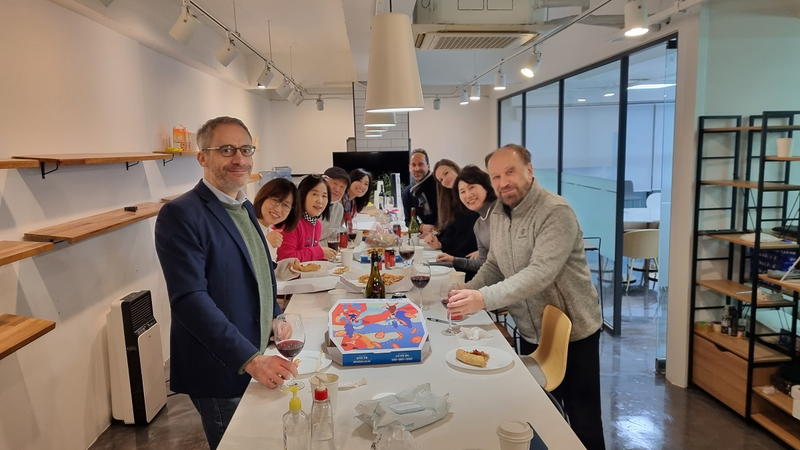
🗓️ Event Details
We are inviting up to 10 participants per session to join a private, off-the-record roundtable discussion on housing experiences in Seoul. Light refreshments will be served.
- Friday, April 12 – Language School Students (e.g., Yonsei KLI, Sogang KLEC)
- Saturday, April 13 – Exchange Students (1 semester or longer)
For each event
- Time: 7:00–9:00 PM
- Location: GIAI Korea Reception Room (Gangnam, Seoul – address upon confirmation)
- Host: GIAI Korea, on behalf of The EduTimes
🧾 Who Should Apply?
We’re looking for students who:
- Are currently living in a one-room or officetel in Seoul, and
- Have previously lived in a private room within a shared flat or house, ideally in Europe or North America
This discussion will focus on the emotional and cultural transition between those two housing styles.
✍️ How to Participate
Please send a short written reflection (200–300 words) to [email protected] by Monday, April 8. Choose one of the following prompts:
- What surprised or frustrated you most about finding housing in Korea?
- If you could redesign student housing in Korea, what would it look like?
All questions or inquiries should be sent to us ([email protected]), but final essay submissions should be sent directly to [email protected], where The EduTimes editorial team will review applications.
- Meet up link: https://www.meetup.com/forum-real-talk-on-student-housing-in-seoul/events/307007701/
- Reddit post to r/yonsei subreddit: Private Forum Invitation - Real Talk on Student Housing in Seoul : r/yonsei
A Final Note
This is not a survey. It’s not a promotional campaign. It’s an attempt to listen—to understand what living in Korea actually feels like for international students.
If you've ever wished your housing here were just a bit more livable, more social, or more aligned with your expectations—this is your moment to speak.
Side note:
As I mentioned in my Reddit comments, I believe I need to do more than just listen, collect, and pass along your stories to Lauren at The EduTimes. We Koreans have a responsibility to fix this.
Back in 2005, I spent a short time living just outside of Shinsekai, Osaka—an area known for having the cheapest accommodations in the city. The landlady, a Korean woman married to a Japanese man, told me she kept her prices low—not to compete with the slums, but because she didn’t want to see any Korean girl end up in a risky situation just for trying to save a few dollars per night.
After walking through Seoul’s Sinchon neighborhood recently, I finally understood what she meant. (To be clear, I’m not saying Sinchon is dangerous in the same way—just that the housing conditions for foreign students are often appallingly low, especially given what they expect from a cultural immersion experience.)
Ultimately, I hope to turn this effort into an official policy proposal to Korea’s Ministry of Culture, Sports and Tourism. The government spends enormous sums each year, yet much of it goes to the wrong places—like renovating remote tourist sites that no one visits. Instead, we should be investing in the neighborhoods where international students actually live. We need to offer safer, more livable, and more culturally compatible housing options—something closer to what students from the West are accustomed to. (Not 15㎡ capsule that none of us want our kids to live in.)
Your firsthand voices can inform The EduTimes' upcoming coverage—but more importantly, they can help us advocate for a better system. I want Korea to do better—for you, and for those who come after you.
Similar Post
[MSc Research topic 2025-2026] Advancing AI-Driven Narrative Intelligence for public opinion
Published
Modified
I have spent years in AI and data science, believing that structured models and quantitative analysis were the future. That perspective changed the moment I became a target of an orchestrated misinformation campaign—one that wasn’t random but designed to destroy my credibility, my institution’s reputation, and my work.
What I witnessed was beyond just social media hate—it was engineered narrative manipulation. The same keywords appeared repeatedly in different online communities, the same phrases were echoed by different sources, and an invisible conductor seemed to be controlling public sentiment. The attacks weren’t spontaneous; they were structured.
Then I asked myself: What if this isn’t just about me? What if this is how narratives are shaped globally—in politics, in business, and in the financial markets?
During my research, I collaborated with a team monitoring public narratives in real time, initially for defensive purposes. They needed a way to detect emerging misinformation, neutralize harmful narratives before they spread, and assess whether their own strategic messaging was effective. The results were game-changing: by tracking word relationships and monitoring sentiment shifts, they were able to counteract disinformation, reinforce positive messaging, and stay ahead of competitors.
That experience made one thing clear: narrative manipulation is a reality, and businesses, financial institutions, and governments need AI-driven intelligence to track, analyze, and respond to it.
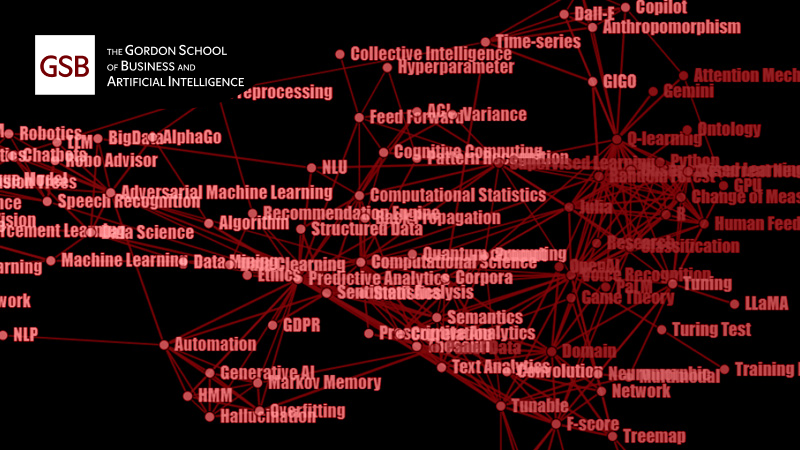
Bridging Academia and Business: AI for Narrative Intelligence
At the Swiss Institute of Artificial Intelligence (SIAI), our MSc AI/Data Science program is committed to pioneering research that bridges theoretical AI concepts with real-world impact. Our latest research focus is on AI-driven word network analysis, a powerful framework for narrative intelligence, crisis detection, and reputation management.
The very example of the network analysis for words is the above image with SIAI's logo and a network array of AI/Data Science related keywords. We have crawled SIAI's lecture notes and created the chart. Below research is to find the best use of the simple mathematics to real world.
Research Overview: Understanding and Controlling Narrative Influence
Traditional sentiment analysis and keyword tracking provide shallow insights, failing to capture the structural relationships behind word networks, narrative evolution, and hidden agenda orchestration. Our approach leverages AI, NLP, and Network Theory to:
- Build narrative networks from large-scale text data (news articles, social media, online communities).
- Detect clusters of related words and topics using graph-based centrality measures (e.g., Betweenness Centrality).
- Identify coordinated messaging efforts and the key actors driving sentiment changes.
- Predict how narratives will evolve over time using Machine Learning, Deep Learning, and Reinforcement Learning.
This methodology enables businesses, investors, and policymakers to analyze the power dynamics behind narratives, revealing not just what is being said, but who is controlling the conversation.
Practical Applications: The Business Case for Narrative Intelligence - Beyond sentiment analysis
This research is not just academic—it has direct, real-world implications. Just as financial institutions rely on algorithmic trading for predictive insights, companies will soon require AI-powered narrative intelligence to safeguard their brand and control public sentiment.
Potential applications include:
- Corporate Risk Management: Identifying reputation threats and misinformation campaigns before they escalate.
- Financial Markets & Hedge Funds: Tracking public narratives that influence stock prices and investment trends.
- Mergers & Acquisitions (M&A): Assessing potential reputational risks before acquiring companies.
- Crisis Management & PR Strategy: Evaluating the effectiveness of messaging strategies in real time.
- Political & Geopolitical Analysis: Understanding how narratives shape public policy and voter behavior.
A Case study: The Business of Monitoring, Defending, and Attacking Narratives
As narrative intelligence matures, businesses will require a structured, AI-driven subscription service to monitor, counteract, and proactively manage their public perception. This research could evolve into:
- A B2B subscription model for corporations to monitor brand sentiment.
- A financial intelligence tool for hedge funds assessing market-moving narratives.
- A cybersecurity and misinformation detection service for governments and media firms.
Let me give you a fictional but realistic example case of using this tool.
Chapter 1: A Brewing Crisis
It started with a single tweet—an anonymous account posted a claim that OrionTech, a rising AI startup, was exaggerating the capabilities of its flagship product, NeuraSync, an AI-driven customer service chatbot. Within hours, the tweet was shared by a prominent tech influencer, and by the next morning, it had made its way onto major tech news sites.
By lunchtime, OrionTech’s marketing team was in full panic mode. Stock prices dipped 4%, venture capital partners were sending urgent emails, and their biggest client was asking for clarification. The PR team scrambled to control the damage, drafting a corporate statement and instructing their social media team to respond—but they had no idea where the fire started or who was fanning the flames.
Then, they turned to their secret weapon: SIAI’s AI-powered narrative intelligence platform.
Chapter 2: Mapping the Attack
As soon as the PR team fed the trending keywords into the system, the word network analysis kicked in. The AI quickly mapped out how the negative narrative was spreading, identifying key word clusters and influential nodes in the network. The system flagged several crucial insights:
- The Anonymous Tweet Wasn’t Random – The AI detected similar phrasing and keywords in older forum posts from months ago, revealing a pattern of coordinated messaging targeting OrionTech. This was not an organic complaint—it was a strategic attack.
- A Competitor Was Involved – The AI identified a subtle but critical connection: many of the accounts amplifying the backlash had also promoted a new product launch from OrionTech’s biggest competitor two weeks prior. A deeper dive into the network graph showed that the same influencer boosting the anonymous tweet had previously collaborated with the competitor’s PR team.
- The Narrative Was Not Yet Fully Cemented – The AI projected that while the sentiment was turning negative, the backlash was still containable—if countermeasures were deployed within 24 hours.
Chapter 3: Counterattack and Narrative Defense
With these insights, OrionTech’s PR team took a multi-layered response strategy:
✅ Neutralize the influencer – Instead of directly confronting the tech influencer who amplified the attack, OrionTech’s CEO invited them for a private demonstration of NeuraSync, offering full transparency. The influencer agreed to an exclusive behind-the-scenes look—leading to a follow-up post praising OrionTech’s technology, shifting the conversation.
✅ Redirect the public narrative – Instead of merely defending against accusations, OrionTech launched a proactive campaign highlighting real customer success stories with NeuraSync. The AI platform recommended specific key phrases and hashtags that would be most effective in steering public perception back in OrionTech’s favor.
✅ Expose the coordinated attack – Without directly accusing their competitor, OrionTech’s PR team leaked data-backed insights to industry journalists, showing how misinformation campaigns were becoming a growing problem in the tech sector. The story wasn’t about OrionTech anymore—it became a broader conversation about ethics in corporate PR warfare, shifting scrutiny away from them and onto industry-wide practices.
Chapter 4: Victory in the Narrative War
Within 48 hours, OrionTech’s AI-driven response had turned the tide:
- Stock prices rebounded by 6% after positive media coverage.
- The influencer’s correction post reached 1.2 million views, overshadowing the initial attack.
- The anonymous tweet stopped gaining traction, and discussions moved on to new topics.
- Venture capital partners re-engaged, reassured by OrionTech’s proactive handling of the crisis.
OrionTech’s executive team had learned a valuable lesson: in today’s world, public perception isn’t just shaped—it’s engineered. Companies that fail to monitor, defend, and shape their narratives will be at the mercy of unseen forces.
But those who harness AI-powered narrative intelligence? They don’t just survive the storm—they control the winds.
Join the Research: MSc AI/Data Science at SIAI
To further develop this study, we seek MSc AI/Data Science students and research collaborators with expertise in:
✅ Natural Language Processing (NLP) for large-scale text data analysis.
✅ Network Theory & Graph Models to model word relationships dynamically.
✅ Machine Learning, Deep Learning, and Reinforcement Learning for predictive analysis and automation.
✅ Game Theory (optional, future expansion) for modeling strategic interactions within narrative control.
Students and researchers participating in this initiative will gain hands-on experience with cutting-edge AI methodologies, real-world applications of graph-based NLP models, and exposure to industry-relevant case studies on narrative intelligence and influence tracking.
If you are interested in joining this research initiative as an MSc student, research collaborator, or industry partner, we welcome applications and inquiries. This is a unique opportunity to contribute to next-generation AI applications in business, finance, and global information ecosystems.
If interested, feel free to ask questions in comments through GIAI Square.
Other related reserach series in 2025-2026 cycle
Similar Post
Why SIAI failed 80% of Asian students: A Cultural, Not Genetic, Explanation
Published
Modified
80% of Korean students failed at SIAI not due to lack of intelligence but due to deep-rooted cultural conditioning that discourages independent thought and risk-taking The Confucian, exam-based education system promotes rote memorization over problem-solving, making students struggle in an environment that requires deep, abstract thinking Korea’s broader economic and corporate structure reinforces a ‘safe thinking’ mindset, making it unlikely that Western-style innovation will thrive here without significant systemic change
Before going into details, please allow me to emphasize that I am well aware that this article is an unfiltered critique, but this also comes from our team's painful 4 years experience in Korea while running a pilot program for MBA AI/BigData and MSc Data Science (PreMSc in AI/Data Science) under our research lead, Keith Lee, a Korean national, whose academic background lies in Mathematical Finance along with Investment banking and Data Science industry experience. Together with below two earlier articles, our analysis so far helps us to conclude that most East Asian countries, except China, are not our target market. For China, we have another mention at the end of this article.
- 3 types of 'Math Genius', 2 of which will be replaced by AI | Global Institute of Artificial Intelligence
- Why SIAI failed 80% of Asian students: A Cognitive, Not Mathematical, Problem | Global Institute of Artificial Intelligence
SIAI was never designed to be an easy program. It is built around problem-first learning, where students must struggle through difficult challenges before being given answers. The idea is that true expertise comes not from memorization but from direct engagement with problems. However, Korean students have failed at a disproportionately high rate, often not because of a lack of intelligence but because they simply could not adapt to this mode of learning.
The failure of Korean students at SIAI is not an isolated incident. It mirrors Korea’s broader struggles in fostering high-risk, innovation-driven industries like AI startups. The same traits that lead to failure at SIAI—risk aversion, hierarchical thinking, and an over-reliance on structured answers—are the same factors that limit Korea’s ability to compete in global high-tech industries.
This raises an important question: If intelligence is not the issue, why do Korean students fail at SIAI at such high rates? The answer lies in deeply ingrained cultural conditioning, reinforced by Korea’s education system and work culture.
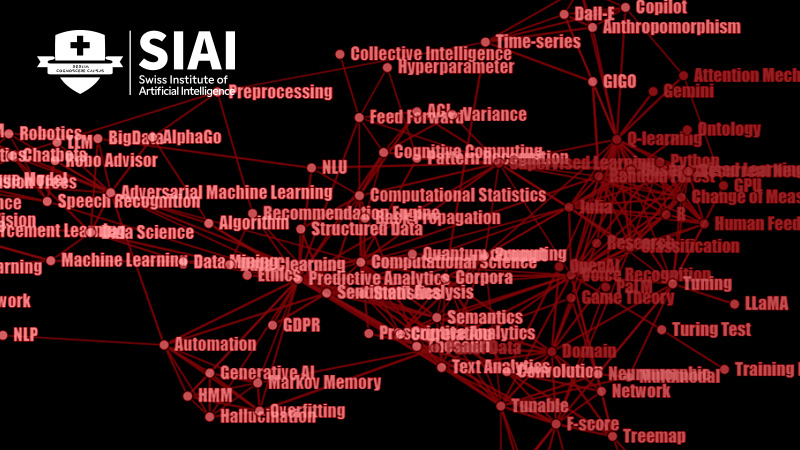
The Education System Teaches Memorization, Not Thinking
Korea’s education system is one of the most intense in the world, yet it produces students who struggle with independent problem-solving. Why?
- The National Exam Mentality – Success in Korea is defined by performance on standardized exams like the CSAT (Suneung). These tests reward students who can memorize massive amounts of information and reproduce it under time pressure.
- Lack of Open-Ended Problem-Solving – Korean students are rarely taught how to deal with ill-defined problems where multiple solutions exist. They are conditioned to expect one correct answer.
- Fear of Making Mistakes – The Korean school system does not encourage risk-taking. Making a mistake is seen as a failure, not a learning opportunity. As a result, Korean students are reluctant to explore ideas that might not lead to immediate success.
At SIAI, students are deliberately given incomplete information and forced to struggle through uncertainty—something the Korean education system has trained them to avoid at all costs. The result?
Mental shutdown, frustration, and high dropout rates.
Students Have a Passive Learning Mentality
A key observation from SIAI’s Korean students is their tendency to:
✅ Wait for direct explanations instead of exploring solutions themselves
✅ Copy existing solutions rather than develop their own
✅ Give up when confronted with open-ended questions
This passive learning mentality is not their fault—it’s a survival strategy that works in Korea’s academic and corporate environments.
- In schools, students are rewarded for following the teacher’s guidance exactly, rather than questioning the material.
- In companies, employees are expected to obey superiors rather than challenge ideas or propose new solutions.
- In social interactions, independent thinking can be seen as arrogance or defiance rather than intelligence.
At SIAI, these habits become a liability. When students are told to figure out a problem before receiving a solution, many experience anxiety and paralysis, as this goes against everything they have been trained to do.
Culture of Risk Aversion Prevents Deep Thinking
Deep, abstract thinking requires a willingness to take intellectual risks—to explore different possibilities, challenge assumptions, and tolerate uncertainty. However, Korea’s society is structured around minimizing risk, not embracing it.
- Corporate & Social Hierarchy – Questioning authority or challenging ideas is discouraged. Instead of debating ideas critically, Koreans are expected to align with the dominant view.
- High-Stakes Consequences for Failure – In Korea, failing an exam or business venture can have lifelong social and economic consequences, making risk-taking too dangerous for most people.
- Short-Term Thinking – Success is measured by immediate results, whether it’s exam scores, company profits, or startup funding. Long-term strategic thinking and foundational research are undervalued.
This cultural mindset clashes directly with the Western-style, research-driven, exploratory approach that SIAI promotes. Students who have spent their whole lives avoiding intellectual risk struggle to suddenly embrace it.
Hierarchical Thinking Limits Creativity & Initiative
Korea’s Confucian-influenced hierarchy impacts how students approach learning and problem-solving:
- Respect for authority over logic – Many students hesitate to challenge assumptions, even when they recognize flaws in a solution.
- Preference for pre-existing formulas – Instead of inventing new methods, students tend to rely on what has already been written or accepted.
- Fear of standing out – Independent thinkers often get labeled as "weird" or "difficult," discouraging students from expressing unique perspectives.
At SIAI, students must develop their own methodologies to solve complex problems. Korean students, conditioned to seek pre-approved frameworks, often struggle with this level of intellectual freedom.
Even if a Korean student somehow overcomes these limitations, their society does not reward them for it.
- Korean corporations hire based on university ranking, not problem-solving skills.
- AI startups struggle because investors prefer “safe” business models over high-risk innovation.
- Government-funded AI projects focus on applications, not fundamental research.
As a result, even Koreans who succeed at Western-style deep thinking often find themselves with no place in Korea’s economy. This reinforces the idea that memorization and safe thinking are the only viable survival strategies.
Korea Is Not Built for Western-Style Innovation
Korea’s failure at producing high-level AI researchers and independent thinkers is not due to a lack of intelligence but rather a fundamental mismatch between its cultural/economic system and the traits required for deep, abstract thinking.
- SIAI’s teaching model aligns with Western academic traditions of independent problem-solving, but Korea’s students are conditioned to avoid risk, challenge, and deep exploration.
- Korean society does not reward the type of intelligence that SIAI promotes. Even students who do well at SIAI may find that Korea has no place for them.
- As a result, Korea is not just failing to produce AI experts—it is failing to cultivate the kind of innovative minds that could drive long-term global competitiveness.
In the end, SIAI was never going to succeed in Korea, because Korea is not built for this kind of education. Raising independent, abstract thinkers here requires enormous effort, but the country itself does not value or support such minds.
For Korea to truly change, it would need to:
- Replace its rote-learning, exam-based education system with research-based learning.
- Encourage intellectual risk-taking and debate at all levels of society.
- Redefine success beyond standardized test scores and corporate hierarchy.
But given the country’s historical patterns, such change is unlikely to happen anytime soon. That is why SIAI has shifted focus to the global market, where its philosophy is more likely to be understood and valued.
For Koreans who wish to truly think independently and engage in deep research, the best path may not be to change Korea—but to leave it altogether.
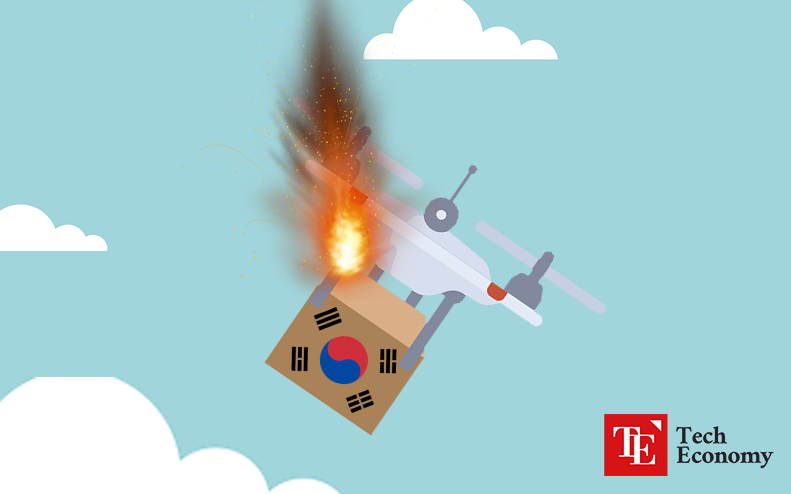
Why I think Korea, once a tech leader, will soon be China's tech colony
As mentioned at the beginning, I am fully aware that it’s an unfiltered critique, but it reflects exactly what I’ve observed over the years together with Keith Lee. He has seen irsthand how these structural barriers prevent not just our students at SIAI, but the entire country, from evolving into a true deep-tech and innovation powerhouse.
This is not about attacking Korea just for the sake of criticism—it’s about identifying why certain types of high-level intellectual pursuits simply don’t thrive there. We tried to break the cycle with SIAI, but the overwhelming response confirmed that Korea isn’t ready, and perhaps never will be. The country is optimized for exam-driven intelligence, corporate hierarchy, and predictable business models—not for nurturing independent, abstract thinkers.
We ’re not alone in this realization. Many of Korea’s most brilliant minds either left the country or had to work under constraints that killed their full potential. That’s why even Korea’s so-called "AI industry" is largely just AWS and OpenAI API integrations rather than real algorithmic breakthroughs.
However, we have witnessed the similar East Asian background but distinctly different stories from China. (Before going any further, please allow me to emphasize that we are not pro-China. We just lay facts and analyses that we have found on the table.)
Despite a similar cultural background, China is making massive strides in AI, semiconductors, and electric vehicles, while Korea seems stuck in safe, incremental improvements. We earlier thought Confucian-structured social system is one of the fundamental cultural influences for Korea's debacle in tech innovation, but we had to change our earlier theory.
Here’s why China is breaking ahead:
1.Massive Long-Term State Investment in Deep Tech
- The Chinese government is willing to pour billions into AI, quantum computing, and electric vehicles, even with no immediate return.
- Korea, on the other hand, only funds projects that have predictable, short-term success—which is why most Korean AI companies just build applications using OpenAI’s APIs rather than actual models.
2.Tolerating Experimentation & Failure
- Chinese tech firms (like Tencent, Baidu, and Huawei) allow moonshot projects to fail because they have strong state backing and long investment cycles.
- Korea’s corporate culture punishes failure harshly, which forces companies to play it safe rather than push technological boundaries.
3.Government-Backed Industrial Policy vs. Market-Driven Hesitation
- China strategically subsidizes key industries (like batteries, EVs, and AI models) to ensure global dominance.
- Korea’s companies, despite having world-class battery tech, have to compete without meaningful government protection.
4.Better Retention of Top Talent
- Many of China’s best AI and deep tech researchers return home from the U.S., thanks to both government incentives and nationalism - Chinese universities' research papers are phenomenal these days.
- Korean researchers, on the other hand, often prefer to stay abroad because they know Korea’s rigid corporate culture won’t let them do meaningful work.
Keith is the best example for this point #4. After years of hopeless trial, he has completely turned his back to his own country and leading our research team here at GIAI. We are glad to have his full attention to GIAI's research and SIAI's Euro operation, but what a loss to his home country.
Among many tech sectors, we admit that there still is Korea's marginal tech lead in EV batteries to China. None of us are EV battery experts, but tracking what they publish in academic (and not-so-academic) journals, we are almost certain that Korea’s battery dominance (LG Energy Solution, Samsung SDI, SK On) is also under threat from China, and it is highly likely that China could soon overtake both Korea and Tesla in EV battery tech.
China’s advantages:
✅ Cheaper production due to massive economies of scale
✅ Aggressive government subsidies that lower manufacturing costs
✅ Faster innovation cycles due to high tolerance for risk
If Korea’s battery makers don’t shift to long-term, high-risk research, they will lose their lead within 5-10 years. And knowing Korea’s business culture, they will likely just play defense rather than take bold steps forward, which will only delay, not prevent, China’s takeover.
My final thought: Korea Is Losing, But It’s a Choice
The key difference between Korea and China is that China is willing to take long-term risks, while Korea isn’t. China sacrifices short-term efficiency for long-term dominance, whereas Korea only funds safe bets with immediate ROI. If Korea wants to stay competitive, it must change how it approaches innovation:
- Fund actual AI research, not just API-based applications.
- Encourage experimental, high-risk tech startups instead of just supporting chaebol-driven projects.
- Give top researchers a reason to stay in Korea instead of moving abroad.
But given Korea’s deeply ingrained corporate and academic structure, I don’t think this change will happen. Instead, Korea will likely continue doing incremental improvements while China overtakes in every major deep-tech sector.
For other East Asian countries, we see that Japan, Mongolia, Vietnam, and other Southern Eastern Asian countries are still in infant stage in AI/Data Science. SIAI's hard training may not have chances to blossom in there, as we already have seen in Korea, for a different reason. If we go to Asia, it will mainly be South Asia and Middle East.
Similar Post
Why SIAI failed 80% of Asian students: A Cognitive, Not Mathematical, Problem
Published
Modified
Not due to math knowledge, but due to difficulty applying knowledge in real-world scenarios accustomed to structured learning, struggle more with open-ended, problem-first approaches compared to those trained in Western-style superficial engagement, reliance on structured guidance, avoidance of ambiguity, and resistance to open-ended problem-solving Failed in abstraction (encoding) and application (decoding)
Since 2021, the Swiss Institute of Artificial Intelligence (SIAI) has refined its approach to teaching AI and data science (DS), learning valuable lessons from our early cohorts of students. One of the most significant insights we have gained is that students do not struggle due to a lack of mathematical knowledge. Instead, they find it difficult to engage with knowledge in a way that allows them to apply it effectively in real-world scenarios.
Many of these difficulties arise from differences in learning styles. Students from highly structured educational backgrounds, particularly those accustomed to traditional Asian learning methods, often face challenges adapting to our problem-first, exploratory approach. Western-style education, which emphasizes independent problem-solving and conceptual reasoning, has proven to be a significant shift for many of our students. While this transition can be difficult, we believe it is essential for real-world success.
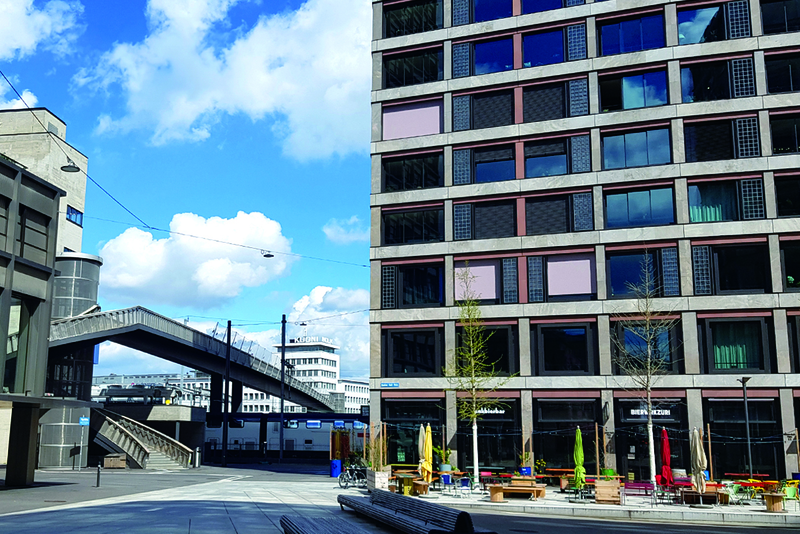
Beyond Math: The Real Challenge
SIAI’s experience over the past few years confirms that success in AI and DS is not just about understanding formulas or solving equations but about knowing how to use this knowledge in practice. Students from various backgrounds have joined our programs, and we have found that their struggles are not necessarily correlated with their university’s prestige. Instead, the greatest challenge for many students has been moving from structured, well-defined problem-solving toward the type of open-ended, real-world thinking required in AI and DS.
Key Observations:
- Students struggle not with math, but with application. Many know the formulas but cannot use them in uncertain, real-world contexts.
- Textbook knowledge is an abstraction. Students must learn to reverse the abstraction process when applying theories in practice.
- Those accustomed to structured, test-based learning struggle the most. They are used to predefined solutions rather than exploratory problem-solving.
Our teaching philosophy is rooted in the belief that textbook knowledge alone is insufficient. Many students fail not because they do not understand theoretical concepts but because they cannot translate those concepts into real-world applications. This is where a significant cognitive gap exists. Textbooks present an abstracted version of reality, simplifying complex problems into models, theories, and equations. However, when students need to apply this knowledge in practice, they must learn how to reverse the abstraction process, translating theoretical models back into the messy, uncertain, and highly variable problems of the real world.
For many students, this transition is difficult because they have been trained to focus on structured problem sets with clear solutions rather than dealing with ambiguous, real-world challenges. Understanding AI and DS is not just about encoding knowledge—it requires decoding reality itself.
In short, a majority of Asian students failed to grasp the concept of encoding and decoding.
Asian vs. Western Learning Approaches
Asian educational systems are well-known for their strong emphasis on procedural mastery, structured problem-solving, and rigorous test-based evaluation. These methods produce students who are highly skilled at following established processes and excelling in standardized assessments. However, while this approach works well for structured learning, it does not always prepare students for fields like AI and DS, which require flexible, adaptive thinking.
Key Differences Between Asian and Western Approaches:
- Asian education emphasizes structure and memorization. Students excel at following predefined formulas but struggle with ambiguity.
- Western education emphasizes conceptual reasoning and exploration. Students are encouraged to justify their reasoning and navigate uncertainty.
- AI and DS require the Western approach. Success in AI depends on solving ill-defined problems and working with incomplete data.
Western education, on the other hand, emphasizes conceptual reasoning, exploratory problem-solving, and open-ended discussions. Students are encouraged to test different approaches, justify their reasoning, and work through uncertainty. Studies, such as a 2019 paper in Cognition and Instruction, have shown that while Western students may not always outperform their Asian counterparts in computational efficiency, they tend to excel in applying knowledge in real-world settings.
At SIAI, we have deliberately adopted a Western-style, problem-first teaching approach because we believe it is the most effective way to prepare students for the realities of AI and DS. Success in this field requires more than technical knowledge—it requires the ability to navigate complexity, adapt to new challenges, and derive solutions without predefined steps.
Key Challenges Faced by Students
From our experience, students who struggle the most at SIAI tend to face the following challenges:
- Superficial Engagement with Learning Materials – Some students read only the surface-level content and assume they have understood it. When asked to explain concepts in their own words or apply them in a different context, they realize they lack a deep understanding.
- Difficulty in Independent Research – Many students expect direct answers rather than seeking out information themselves. This reliance on structured guidance prevents them from developing the self-learning skills necessary for AI and DS careers.
- Avoidance of Struggle and Ambiguity – In AI and DS, many problems do not have clear-cut solutions. Some students become frustrated when they cannot immediately find the “right” answer, leading them to disengage rather than persist through trial and error.
- Lack of Open-Ended Thinking – AI and DS require working with incomplete information and making educated decisions based on limited data. Some students resist this uncertainty, preferring problems where a single correct answer exists.
Why We Focus on Western-Style Education
Over the past four years, we have refined our approach at SIAI to focus on what truly matters: bridging the gap between theory and real-world problem-solving. While some students initially struggle with this transition, those who push through emerge as independent thinkers capable of tackling complex AI and DS challenges.
Our Core Teaching Principles:
- Textbook knowledge is not enough. Students must learn how to apply theory to real-world, uncertain environments.
- AI and DS require adaptive thinking. Rigid, structured learning does not translate well to real-world challenges.
- Western-style education fosters independence. Our program forces students to solve problems autonomously, just as they will need to do in the workforce.
Our message to students is clear: success in AI and DS is not about memorizing more formulas or perfecting structured exercises. It is about developing the ability to think, adapt, and problem-solve in the face of uncertainty. Those who embrace this challenge will thrive. Those who remain dependent on structured, execution-based learning will find it difficult to transition into real-world applications.
At SIAI, we do not fail students. We provide the environment and challenges necessary for growth. It is up to students to make the transition from structured learners to adaptive problem-solvers. Those who succeed will find that this transformation is not only valuable for AI and DS but for any complex field where innovation and independent thinking are required.
What does SIAI take going forward
From this painful experience over the past four years, we have shifted our focus of admission from academic credentials to encoding/decoding flexibility. Our earlier assumption that outperformance in earlier schooling can be a persuasive indicator of academic and business success at and beyond SIAI has been disproven by 100+ students from Asia.
Although we do believe western schools run higher education with significantly different direction, it has come to our attention that siding with specific background may limit our potential to grow in network and more creative thinking.
From the understanding all together, going forward, the admission process will mainly focus on whether students can overcome hurdles each by each. More skillful,, versatile, and flexible students will have less trouble overcoming the hurdles, and those the key features we believe will be the very key of the academic success at SIAI as well as future success in the field. In the end, all students will be benefited by our alumni network.
Similar Post
AI Bootcamp vs. SIAI’s AI MBA: The Future of AI Careers
Published
Modified
AI Bootcamps provide emotional satisfaction but no real AI knowledge. SIAI’s AI MBA (Business & Tech Tracks) offers real AI project exposure and strategic thinking. Basic software engineers will be obsolete by 2035, replaced by AI and offshore talent
After launching AI MBA's business track, we sometimes have questions about the value of the track. Most people, particularly, engineers think that's just a waste of time. Some of them even claim that AI Bootcamp is the better option, as it costs less money.
Do I and do all GIAI members agree? Far from it.
From our perspective, AI Bootcamp really has no value. It is designed in a way to make easy money from AI hype. Can they modify AI libraries for company's specific needs, just as an example? Sometimes we also have to sit down together to read mathematical logic from the libraries. We seriously doubt that any of bootcampers are capable.
On the contrary, in AI MBA's business track, you get to see what PreMSc and AI MBA's technical track students do. You can really see what true AI/Data Science is. This will not help you to become an AI engineer, unfortunately, but it will at least help you to make decisions like:
- Stop hiring incompetent fake AI engineers (bootcamp level)
- Stop spending $$$ for superfluous GPUs
Let's face to the reality. You are not good at math. Then, you can never be true AI/Data Science expert. Going to AI Bootcamp gives you still nothing. Nothing at all. AI MBA's business track? You can at least open your eyes to tell what is right and what is wrong. That will help companies to save tons of money.
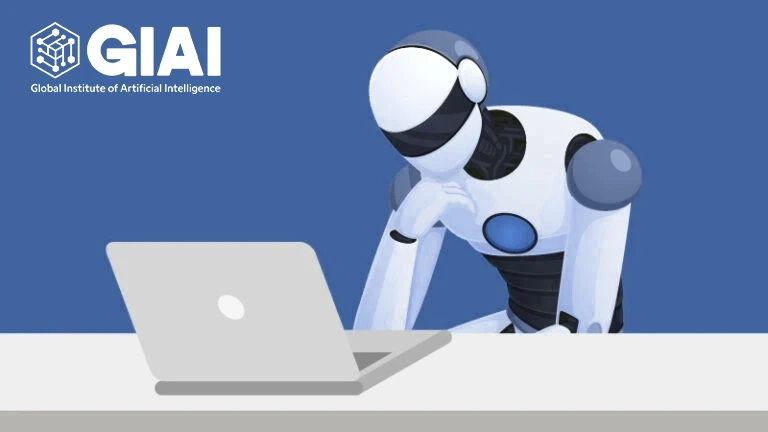
AI Bootcamp = Emotional Satisfaction, Not Real Knowledge
✔ Bootcamps teach surface-level AI, focusing on short-term gratification rather than deep learning.
✔ Most bootcamp grads can barely explain the math behind models, let alone build something from scratch.
✔ Bootcamps are designed for quick "I-feel-like-an-expert" dopamine hits, not actual expertise.
✔ Executives and engineers who take bootcamps walk away feeling like they "understand AI"—but they don’t.
Executives Who Attend AI Bootcamps
❌ Walk away with buzzwords, not knowledge.
❌ Think they can now "manage AI teams" but lack real understanding of AI costs, risks, and limitations.
❌ Bleed money hiring the wrong people (bootcamp grads) or investing in the wrong infrastructure (GPU waste).
Engineers Who Attend AI Bootcamps
❌ Believe running pre-built models = AI expertise.
❌ Have no math foundation, so they can’t debug models or understand statistical failures.
❌ Are helpless without TensorFlow/PyTorch tutorials—they don’t actually understand what’s happening under the hood.
➡ Conclusion: AI Bootcamps are a complete waste of time and money. They don’t teach anything that can actually be applied in real AI projects.
I am sorry to be bold but If you want a real career in AI, a structured, rigorous program like SIAI’s AI MBA is the only way forward.
SIAI’s AI MBA: Business Track vs. Bootcamp
If bootcamps don’t teach real AI, then what’s the better alternative?
For executives: SIAI’s AI MBA Business Track
For engineers: PreMSc Prep Courses (or switching tracks if they can’t handle it).
Why Executives Should Choose SIAI’s AI MBA Business Track Instead of a Bootcamp
✔ Instead of shallow AI knowledge, they get real AI project exposure.
✔ Learn how to hire the right AI engineers (and why bootcamp grads are useless).
✔ Understand where AI actually makes money instead of wasting money on GPU-heavy nonsense.
✔ Can even try technical track courses if they’re bold enough, ensuring they know what’s realistic and what’s hype.
💡 End Result?
Executives who actually understand AI decision-making—not just a list of buzzwords from a weekend bootcamp.
Why Engineers Should Avoid Bootcamps and Take the Prep Courses Instead
For engineers, bootcamps give them a false sense of competence—but when faced with real AI work, they collapse.
✔ If they’re weak in math, they should start with the PreMSc Prep Courses.
✔ If they can’t handle even that, they should switch to business track and accept reality.
✔ If they stay in business track, they will feel self-deprecation watching smarter students do real AI work.
💡 End Result?
Engineers who can handle real AI will survive.
The rest should accept their limitations and pivot into AI strategy roles.
Again, sorry to sound too brual, but those who fail the prep courses (AI MBA's first two courses) should pivot, instead of forcing themselves into a field they’re not suited for. Why? Because your job will soon be replaced by offshore (Indian, for example) devs and ChatGPT like AI services.
Are Basic Software Engineers Becoming Obsolete?
Your prediction is largely correct—but with some nuances.
✔ Basic coding (CRUD apps, simple web dev, basic scripting) is already being automated by AI.
✔ Most entry-level programming tasks are now achievable with ChatGPT, Copilot, and other AI tools.
✔ Large companies are offshoring low-to-mid-tier development to India and other countries with cheaper labor pools—Western developers are getting squeezed out.
✔ Only the highest-end engineers—those with deep system knowledge, performance optimization expertise, and mathematical rigor—will remain indispensable.
In other words, mediocre software engineers will struggle in the next decade. Then, who will surive? We believe only the following two types.
1. High-End, Specialized Engineers (Unreplaceable by AI)
These are the software engineers who will still be valuable in 10+ years:
✔ Systems Engineers – Experts in OS, networking, compilers, and embedded systems.
✔ Algorithm & Optimization Experts – Those who can implement custom AI models, efficient algorithms, and numerical methods.
✔ Mathematical & Scientific Programmers – People who develop scientific computing tools (e.g., Quant Finance, Computational Physics, Bioinformatics).
✔ Cybersecurity & Cryptography Experts – AI can’t fully replace defensive security strategies.
✔ Edge AI & Hardware Engineers – Those who optimize AI models for real-time, low-power, embedded systems.
🚀 Survival Strategy:
- Learn low-level engineering (C++, Rust, Embedded AI, OS internals).
- Master computational methods, not just software frameworks.
- Get into deep AI research, instead of just using AI models.
2. AI-Strategic Business Leaders (Who Use AI Instead of Competing With It)
For engineers who can’t reach the highest technical levels, there’s an alternative:
➡ Pivot to AI strategy, business, and decision-making.
✔ AI Product Managers – Experts who bridge the gap between AI research and product development.
✔ AI-Driven Entrepreneurs – People who build companies that leverage AI without being engineers themselves.
✔ AI Finance & Investment Experts – Those who evaluate which AI startups are real vs. hype-driven scams.
✔ AI Policy & Regulation Specialists – Governments need experts who understand AI risks, compliance, and governance.
🚀 Survival Strategy:
- Stop fighting AI head-on and start using it strategically.
- Understand where AI can be profitable, instead of just coding.
- Develop decision-making skills that AI can’t replace.
This is where SIAI’s AI MBA Business Track becomes the smartest move.
Why? The industry will look very different by 2035—and those who fail to adapt will be completely obsolete. So, for you to better understand what will happen, we have created a fictional story about Adam, Brian, and Charlie.
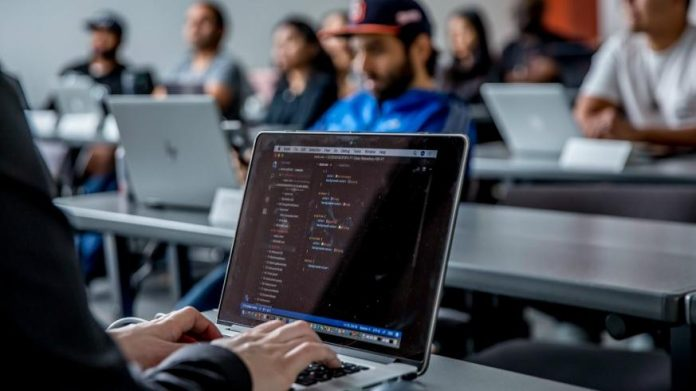
AI Bootcamp vs. AI MBA: The Story of Three Paths in the AI Era
In the early 2020s, AI was the hottest trend in tech. Every company wanted an AI strategy, every engineer wanted to become an AI expert, and every business executive wanted to invest in AI-powered solutions.
Among those caught in the wave were three college friends: Adam, Brian, and Charlie. They had studied together, worked on projects together, and often spent sleepless nights debugging code. But when AI took over the world, their paths diverged—leading to three very different outcomes by the year 2035.
This is their story.
Adam—The AI/Data Science Expert Who Leads the Future
Adam had always been the analytical one. During his undergraduate studies in Economics, he had fallen in love with econometrics and mathematical modeling. Unlike his peers, who viewed math as a painful requirement, Adam saw it as the key to understanding complex systems.
When AI started disrupting industries, Adam knew that surface-level AI wasn’t enough. He saw countless self-proclaimed AI engineers who could train models but had no understanding of why those models worked.
Determined to build real expertise, Adam joined SIAI’s PreMSc program, where he was pushed to his intellectual limits. The curriculum was brutal—probability theory, optimization, deep learning architectures—but he thrived. He moved on to SIAI’s MSc in AI/Data Science, completing two years of rigorous training.
By 2035, Adam was leading an AI division in a Fortune 500 company, tackling some of the most challenging AI problems in the industry. Companies fought over him, offering contracts worth millions. He wasn’t just an engineer running pre-built models—he was an AI scientist designing the future.
When asked about his success, he simply said:
AI isn’t about running models. It’s about understanding the world mathematically. If you don’t get that, AI will replace you instead of you building AI.
Brian—The AI-Savvy Business Leader Who Saved Millions
Unlike Adam, Brian had never been a fan of math. He had majored in Computer Science, but whenever advanced calculus or probability theory appeared, he instinctively looked for ways to avoid it.
In the mid-2020s, AI hype was at its peak. Bootcamps promised fast-track careers in AI with no math required. Excited by the opportunity, Brian enrolled in two AI bootcamps.
But reality hit hard.
The bootcamps taught pre-built AI libraries but failed to explain how or why models worked. Brian started to realize that he wasn’t actually learning AI—he was just copy-pasting code.
Frustrated, he joined SIAI’s PreMSc Prep program, hoping to finally break into real AI. But after months of struggling with advanced mathematics, he admitted to himself: AI wasn’t for him.
But instead of quitting entirely, Brian made a smart pivot. He switched to SIAI’s AI MBA Business Track, where he learned how AI really works in companies, how to hire real AI talent, and how to avoid costly AI mistakes.
By 2035, Brian was a senior AI executive, overseeing AI projects and hiring top AI engineers. Unlike other managers who blindly approved AI budgets, Brian knew exactly what mattered.
He cut unnecessary GPU spending, refused to hire overpriced but incompetent AI engineers, and saved his company millions.
When his company needed a new AI leader, Brian didn’t waste time—he reached out to his old classmate, Adam.
I spent years watching AI managers burn money on useless projects, They hired the wrong people, bought too much hardware, and failed to ask if AI was even needed. I built my career by not making those mistakes.
Charlie—The Self-Taught Kaggle Expert Who Became Obsolete
If Brian had doubts about AI bootcamps, Charlie fully believed in them.
When the AI hype started, Charlie rejected traditional education.
AI is an open field. You don’t need a degree, just learn from Kaggle.
He spent years grinding Kaggle competitions, improving his ranking day by day. He became a well-known name in the AI community, praised for his leaderboard achievements.
But Kaggle rewards gaming the system, not solving real problems. Charlie mastered brute-force hyperparameter tuning, but he never learned how to build AI solutions for real-world business needs.
For years, he coasted on his reputation—until his old friend Brian returned from his AI MBA.
Brian, now an AI executive, quickly realized that Charlie’s Kaggle expertise was useless in production AI. His entire workflow could be automated with ChatGPT.
When Brian’s company needed to optimize AI operations, he hired Adam instead of Charlie.
Within months, Adam built an internal AI system that replaced Charlie’s entire team. By integrating ChatGPT-style automation, Adam achieved in hours what Charlie and his colleagues used to do in weeks.
By 2035, Charlie found himself in a dying industry.
Afterwords in 2035—The cost of right and wrong choices
After launching an internal version of ChatGPT for the company, Adam got numerous job offers from Fortune 500 companies desperately looking for internalizing and customizing the advanced AI algorithm. His salary got tripled and he became the team leader of the AI division.
Now, in every year, Brian, as an HR executive for AI brains, goes to SIAI's annual job fairs to hire a smart recent graduate who can be as effective as Adam. He also offers full scholarship for PreMSc graduates' study in next year's MSc on the condition that they will join after the graduation. Hunting brains in this field becomes more and more competitive.
Charlie could find jobs for a few years, but companies soon replaced him by offshore software engineers from India and ChatGPT. Charlie is no longer an AI expert, but more importantly, he is no longer an engineer. His Uber driver job got also replaced by self-driving services.
The Final Lesson—AI Bootcamps and Self-Teaching Are No Longer Enough
By 2035, the world of AI had sorted itself out:
- The real experts (like Adam) were in high demand, leading cutting-edge AI innovations.
- The AI-savvy business leaders (like Brian) were running AI projects efficiently, saving their companies millions.
- The bootcamp-trained engineers and self-taught Kaggle competitors (like Charlie) were struggling to stay relevant.
AI Bootcamp Graduates:
❌ Learned only surface-level AI.
❌ Got outperformed by AI-powered automation.
❌ Became easily replaceable by cheaper offshore talent.
SIAI AI MBA Graduates (Business or Tech Track):
✔ Gained real-world AI knowledge and strategic thinking.
✔ Built careers in high-value AI roles that AI itself couldn’t replace.
✔ Had the option to switch tracks, ensuring they maximized their strengths.
Do you think the fictional story too fictional?
Similar Post
Beyond STEM MBAs: The Real Value of SIAI’s Business Track
Published
Modified
Over the past few years, there has been a growing trend of STEM MBAs—business programs that integrate basic AI, analytics, and coding to appeal to professionals interested in tech-driven industries. While these programs may sound promising, in reality, most STEM MBAs provide little more than bootcamp-level technical training, leaving graduates with surface-level AI knowledge and little ability to differentiate real AI innovation from hype.
At SIAI, we took a different approach. Instead of trying to turn business professionals into mediocre AI engineers, the MBA business track is designed to develop leaders, investors, and strategists who deeply understand AI/DS projects without needing to be coders themselves. This track is not about learning how to code—it’s about learning what truly defines AI and how to make high-level decisions in AI-driven industries.
The Core Differentiator: Real Exposure to AI/DS
The biggest misconception about AI/DS business education is that adding some Python, SQL, or AI case studies to an MBA makes it ‘AI-literate.’ That is not the case. SIAI’s business track is different because it provides real exposure to how actual AI/DS projects are built, researched, and implemented.
- Understanding the AI/DS workflow: Business track students work alongside technical track students to see what real AI work looks like, ensuring they can assess technical teams and projects effectively.
- Distinguishing real AI from marketing gimmicks: Unlike traditional MBAs, where students may accept AI at face value, SIAI business students learn to challenge claims, ask the right questions, and recognize when AI is being used as a buzzword rather than a real innovation.
- Deep case studies of AI startups and failures: Instead of vague AI business trends, students analyze real AI companies—both successful and failed—learning why some AI businesses succeed and why others collapse under hype.
Breaking the AI Illusion: Case Studies That Challenge False Beliefs
Many business professionals and executives today have a false belief that AI is a kind of magic—something that can be applied to any business problem with instant success. One of the key objectives of SIAI’s business track is to break these illusions and teach students how to separate reality from hype.
To achieve this, students engage in case studies such as:
- "Evaluating an AI Startup’s Real AI Capability" – A deep dive into how investors and business leaders can assess whether an AI startup has actual technical substance or is simply selling buzzwords. This includes examining the startup’s tech stack, team composition, and data pipeline to detect red flags.
- "How to Handle Your AI-Believer or Deep Learning Maniac Boss?" – A practical guide on how to deal with executives or investors who have unrealistic expectations about AI. Students learn how to communicate AI’s real capabilities and limitations using strategic reasoning rather than technical jargon.
- "Why AI Startups Fail: A Post-Mortem Analysis" – A comparative study of AI startups that succeeded vs. those that failed, analyzing what went wrong in business execution, technology scalability, or investor misjudgment.
Unlike the technical track, which breaks the AI illusion through math and code, the business track does so through critical analysis, case studies, and strategic reasoning.
Why This Matters for Venture Capital and Private Equity
One of the most valuable career paths for business track students is AI-focused investment—whether in Venture Capital (VC), Private Equity (PEF), or AI-driven corporate strategy. However, the problem today is that most investors lack the technical depth to properly evaluate AI startups and investments.
Many VCs and PEFs invest in AI companies based on networking and news-driven hype rather than real technical evaluation. This has led to a cycle of funding low-quality AI startups while overlooking companies that have true AI potential.
SIAI’s business track directly addresses this gap by training students to:
- Identify which AI/DS teams are technically competent.
- Assess the scalability and economic viability of AI models.
- Avoid common investment mistakes in AI and deep-tech sectors.
- Guide AI companies with better strategic insights than traditional MBAs.
In fact, GIAI, the mother institution of SIAI, has plans to launch its own investment vehicles in AI, including both a hedge fund (for computational finance) and a VC/PEF firm (for AI startups and deep-tech investments). Business track students who complete this program will be far better prepared for real-world AI investment decisions than their counterparts from traditional MBA programs.
Breaking Away from the Bootcamp-Style AI Education Model
Many business students mistakenly assume that learning basic AI development in a bootcamp-style MBA makes them AI experts. In reality, most AI bootcamps and business-oriented AI courses:
- Teach outdated or simplified AI techniques that don’t reflect real industry practices.
- Fail to distinguish between software engineering and AI/DS research.
- Provide surface-level coding exposure rather than deep conceptual understanding.
SIAI’s business track is designed to help students escape this flawed educational model by focusing on real AI exposure, deep case studies, and an investment-oriented mindset rather than shallow technical training.
Conclusion: AI Business Leadership That Matters
SIAI’s business track isn’t for those who want to ‘add AI to their resume’ without truly understanding it. Instead, it’s for those who want to be credible leaders in AI-driven industries, whether in investment, strategy, or entrepreneurship.
With AI transforming every sector, the market no longer needs more business professionals with superficial AI knowledge—it needs business leaders who can differentiate real AI from hype, support technical teams effectively, and make investment decisions that shape the future of AI.
For those who are ready to go beyond traditional STEM MBAs and bootcamp-style AI education, SIAI’s business track provides the foundation for making meaningful contributions in AI/DS-driven industries.
